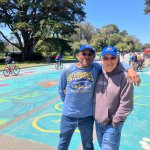Last week’s hearing on traffic enforcement: what it means, what we’re watching
Last week, Walk SF was at a long-anticipated hearing called by District 8 Supervisor Mandelman on the San Francisco Police Department’s plan for how it will restore traffic enforcement.
Traffic enforcement – which includes enforcement of the five most dangerous driving behaviors – has been at historically low levels for more than three years now.
Meanwhile in San Francisco and nationwide, the pandemic accelerated disturbing trends in dangerous driving, especially the deadliest behavior of speeding.
Walk SF believes that how streets are designed is the most crucial piece of protecting pedestrians. But we also believe that the SFPD has a role to play in traffic safety, particularly with egregious speeding. And with the City set to become the first city in California to launch 33 speed cameras in early 2025, the SFPD could play a key, complementary role in helping shift driver behavior at a broader scale.
So we were all-ears at the hearing. The SFPD shared a six-month plan, which they will assess and report back on to determine their approach in 2025.
Our take-aways on the SFPD’s new, six-month traffic enforcement plan:
- SFPD will focus its traffic enforcement division (approximately 30 traffic officers) on the most dangerous driving behavior, which is speeding. Given that speeding is the #1 cause of severe and fatal crashes in San Francisco, Walk SF supports this focus.
- Officers will be directed to data-driven locations throughout the city at speeding hotspots, at high-visibility locations, and in an ongoing way. Walk SF supports this: San Francisco needs consistency to change driver behavior and a much more strategic approach. We also believe more coordination is needed between SFPD, SFMTA, and the Department of Public Health in support of this commitment. For example, the SFMTA just finished a robust speed data collection effort at 70 locations around the city in determining the placement of speed cameras. This data needs to be integrated into the SFPD hot-spot locations.
- The SFPD is using a new database, Benchmark, to track not only citations also warnings now. This information will be available on an interactive dashboard. Walk SF believes transparency is key so that SFPD’s efforts are effective, efficient, and equitable. Note that Walk SF is part of a coalition of 65+ organizations that want to end biased, pretextual traffic stops in San Francisco that are for minor offenses that are often used as a pretext to search people, which data shows are racially-biased.
The SFPD will come back to the Board of Supervisors’ Public Safety and Neighborhood Services Committee in six months to report back on their new plan. Walk SF will be meeting regularly with SFPD to discuss progress and will keep you posted.




